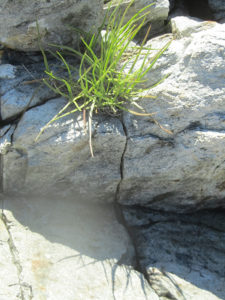Space within the stones

Living, as we do, in the Finger Lakes Region of New York State, it is impossible to not reflect on the evolutionary process that has transformed the landscape all around us. The same forces that shape the land – the turning earth, gravity, wind, water, sun and changes in temperature – also shape us.
One of the recurring themes and ideas that have always fascinated me is the ability of individuals, flora and fauna, to find minute niches in which they can survive – and thrive. One can see examples of this all around us. One of my favorites is when plants – columbines, grasses, ferns and aged cedars – find places to grow amidst the rocks that have been left behind.
This amazing adaptation, as the seed from a single survivor nestles into a minute, dust-filled crevice, seems to defy the laws of nature that condemns some to an untimely demise. Indeed, rather than seeing these small beings as occupying a tiny space that fate favorably found them, it seems that they are the forces that tear apart the very stone within which they lie.
I have walked in the boulder field in Hickory Run State Park in Pennsylvania, which, most believe, was formed when bedrock was exposed during the last ice age. As glacial melt flowed across the rock and froze repeatedly in the minute cracks of this massive sheet of stone, it broke the sheet into pieces. Then weathering, from all the forces of nature, gradually wore the stones into rounded boulders.
Walking across these eighteen acres of stone, there are examples of found niches everywhere. Plants and animals living amongst the various stones have each found a way to prosper cooperatively within the small spaces left by time. As they burrow and grow, they change the environment; pebble-by-pebble, grain-by-grain, they act upon the land.
Their existence is not so much one of competition, although their ability to adapt has brought them to where they are. It is, rather, a fitting together of different individuals with different needs into a complex eco-system.
This ecological progression is part of an endlessly changing evolutionary process. Nothing remains constant, and we all find ways to adapt, to maintain a balance, to co-exist and thrive by finding that perfect niche.
D.E. Bentley –
Editor, Owl Light News